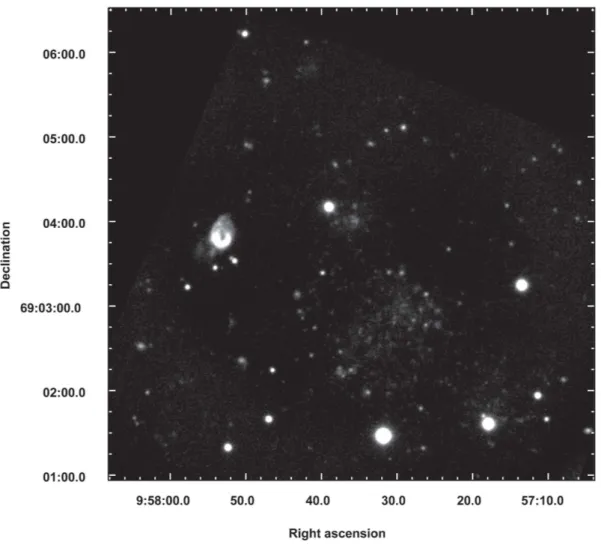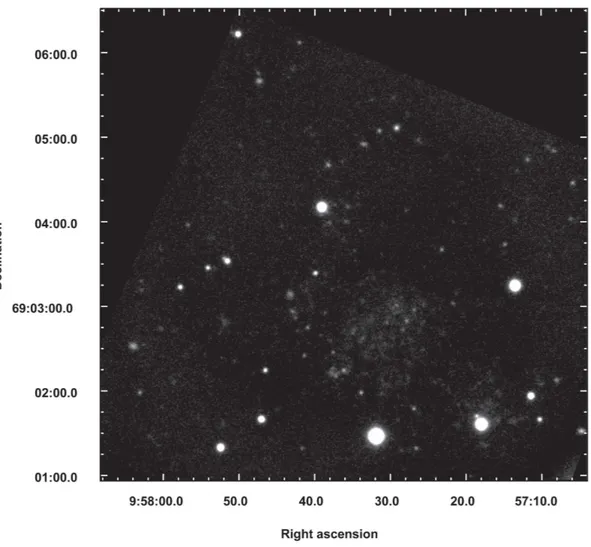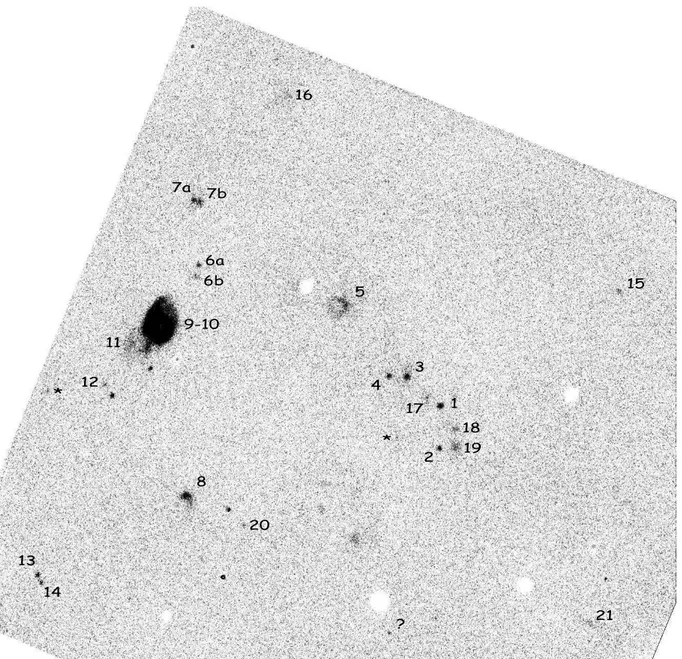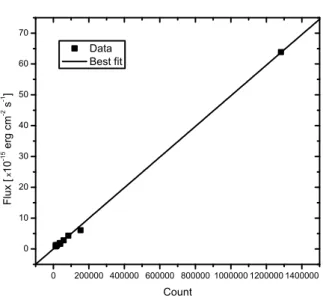Serb. Astron. J. } 179 (2009), 87 - 94 UDC 524.7 : 520.822
DOI: 10.2298/SAJ0979087A Preliminary report
OPTICAL OBSERVATIONS OF M81 GALAXY GROUP
IN NARROW BAND [SII] AND H
αFILTERS: HOLMBERG IX
B. Arbutina1
, D. Ili´c1
, K. Stavrev2
, D. Uroˇsevi´c1
, B. Vukoti´c3
and D. Oni´c1 1
Department of Astronomy, Faculty of Mathematics, University of Belgrade, Studentski trg 16, 11000 Belgrade, Serbia
E–mail: arbo@matf.bg.ac.rs
2
Institute of Astronomy, Bulgarian Academy of Sciences, 72 Tsarigradsko Shosse Blvd., BG-1784 Sofia, Bulgaria
3
Astronomical Observatory, Volgina 7, 11160 Belgrade, Serbia
(Received: June 11, 2009; Accepted: July 27, 2009)
SUMMARY: We present observations of the nearby tidal dwarf galaxy Holmberg IX in M81 galaxy group in narrow band [SII] and Hαfilters, carried out in March and November 2008 with the 2m RCC telescope at NAO Rozhen, Bulgaria. Our search for resident supernova remnants (identified as sources with enhanced [SII] emission relative to their Hαemission) in this galaxy yielded no sources of this kind, besides M&H 10-11 or HoIX X-1. Nevertheless, we found a number of objects with significant Hαemission that probably represent uncatalogued HII regions.
Key words. ISM: supernova remnants – HII regions – Methods: observational – Techniques: photometric – Galaxies: ISM – Galaxies: individual: Holmberg IX
1. INTRODUCTION
M81 galaxy group is the nearest interacting group of galaxies, with the main members being M81, M82 and NGC 3077. Yun et al. (1994) found promi-nent HI structures surrounding these galaxies with large HI complexes and tidal bridges, that are prob-ably a result of the galaxy encounters. It is possible that starburst activity, i.e. the enhanced star forma-tion, of M82 was triggered in a close encounter with M81, which as a consequence has a high supernova rate (see e.g. Arbutina et al. 2007, Huang et al. 1994). The third member of the group, NGC 3077, also shows evidence of the enhanced star formation, and, consequently, a higher supernova rate and pres-ence of SNRs. This was partially confirmed by recent radio observations (see Rosa-Gonzales 2005). There
B. ARBUTINAet al.
Fig. 1. The [SII] with continuum image (sky subtracted).
Table 1. Data for Holmberg IX (MCG+12-10-012) taken from SIMBAD†.
Right ascension Declination Redshift Velocity Distance‡ Angular size Magnitude Morphological
αJ2000 δJ2000 z v [km s−1] d[Mpc] [′ ] type
09 57 32.1 +69 02 46 0.000213 64 3.7 2.6×2.2 16.5 (B) dI
†http://simbad.u-strasbg.fr/simbad/ ‡Karachentsev and Kashibadze (2006)
The adopted distance to Holmberg IX isd= 3.7 Mpc, which is the distance derived from cepheids distance to M81 and known membership in the M81 group (Karachentsev et al. 2004, Karachentsev and Kashibadze 2006). The location of Holmberg IX, its high gas content, and its youthful stellar population, made of this galaxy the primary target of our search.
Table 2. Characteristics of the narrow band filters. Filter λo [˚A] FWHM [˚A] τmax [%]
[SII] 6719 33 83.3
Hα 6572 32 86.7
OPTICAL OBSERVATIONS OF M81 GALAXY GROUP
Fig. 2. The Hαwith continuum image (sky subtracted).
Table 3. The observations log. Integration time [s]
Object/SS 2008 March 3 2008 November 30 Cont. Hα [SII] Cont. Hα [SII]
1800 1200 1200 1800 1200 1200
Holmberg IX 1800 1800 1800 1800 1200 1200
2400 1800 1800 1800 1200 1200
180 120 120 – – –
Feige 34 240 120 120 – – –
180 120 120 – – –
– – – 300 120 120
G191-B2B – – – 300 120 120
B. ARBUTINAet al.
Fig. 3. The red continuum image (sky subtracted).
2. OBSERVATIONS AND DATA REDUCTION
The observations were carried out in March and November 2008 with the 2 m Ritchey-Chr´etien-Coud´e (RCC) telescope at the National Astronom-ical Observatory (NAO) Rozhen, Bulgaria (ϕ = 41◦41′35′′, λ= 24◦44′30′′, h= 1759 m). In the RC
focus of the telescope, the equivalent focal length is 16 m and the field-of-view is one square degree with a scale 12 .′′89/mm. The telescope is equipped with
VersArray: 1300B CCD camera with 1340×1300 px array, and the plate scale of 0 .′′257732/px (pixel size
is 20µm), giving a field of view of 5′45′′×5′35′′.
We used the narrow-band filters for [SII], Hα
and red continuum. We took sets of three images through each filter, on both nights, with exposure times ranging from 1200–2400 s. Typical seeing was 1 .′′5 – 3′′. Standard stars images (Feige 34 and
G191-B2B), bias frames and sky flat-fields were also taken. Filters characteristics and details of the observations
are given in Tables 2 and 3. The Hαimage (λ6563) is contaminated with some [NII] emission (λ6583), so in principle the ”Hα” is actually Hα+[NII] image. The [SII] filter should collect most of the emission from both [SII] λ6716 andλ6731 lines.
Data reduction was performed by using IRIS1
(an astronomical images processing software devel-oped by Christian Buil). The data were bias sub-tracted and flat-fielded using the standard meth-ods. Three images in each set are combined us-ing proceduresNGAIN3andCOMPOSIT, and then sky-substructed (SUBSKY). Commands MAX, MIN, EDGE were used for cosmetic corrections (bad pixels, cos-mic rays removal). Since the images were taken with different exposures, depending on the filters, we scaled all the images normalizing them to the flux of the stars in the field. Images taken on two nights are then combined to increase the counts, rotated, aligned and distortion corrected by using the pro-cedure COREGISTER. Images obtained after all these corrections are given in Figs. 1–3.
1
OPTICAL OBSERVATIONS OF M81 GALAXY GROUP
Fig. 4. The continuum-subtracted Hα image. Dark features that are marked are sources. Additional dark features are stars not subtracted well (compare Figs. 2 and 3).
The Hαand [SII] images are then continuum-subtracted and final images once again background subtracted to obtain background as flat as possible. The continuum-subtracted Hαimage is given in Fig. 4.
Sources in the continuum-subtracted Hα im-age are extracted by smoothing the imim-age and then drawing 1σ contours from the median value. Rela-tive fluxes (total counts) are then calculated using IRIS photometric tools. Finally, an astrometric re-duction of the Hαimage was performed by using U.S. Naval Observatory’s USNO-A2.0 astrometric cata-logue (Monet et al. 1998).
3. ANALYSIS AND RESULTS
B. ARBUTINAet al.
0 200000 400000 600000 800000100000012000001400000
0 10 20 30 40 50 60 70 Data Best fit F l u x [ x 1 0 -1 5 e r g cm -2 s -1 ] Count
Fig. 5. Flux – Count (F−N) relation used for ab-solute calibration. Slope of the relation is calibration coefficient: c= (4.97±0.05)×10−5.
Table 4. Sources used for absolute calibration. HαFlux Source Count [×10−15erg cm−2s−1]
this paper from M&H
M&H 1 20721 1.30
M&H 2 12884 1.27
M&H 3 38559 1.65
M&H 4 17229 0.99
M&H 5 83939 4.32
M&H 6 12807 0.83
M&H 7 36059 1.92
M&H 8 57565 2.83
M&H 9-10 1282274 63.87 M&H 11 153357 6.10
Eleven sources (1–11) were previously identi-fied by Miller and Hodge (1994) and one by Boone et al. (2005) (source 12).2
Thus, we found nine new sources (13–21).
Table 5. HII regions in Holmberg IX.
Source Right ascension Declination HαFlux Comment
αJ2000 δJ2000 FHα[×10
−15
erg cm−2
s−1
]
Aea 1 09 57 26.1 +69 03 09 1.03 M&H 1
Aea 2 09 57 26.2 +69 02 47 0.64 M&H 2
Aea 3 09 57 29.4 +69 03 24 1.92 M&H 3
Aea 4 09 57 31.1 +69 03 24 0.86 M&H 4
Aea 5 09 57 35.6 +69 04 01 4.17 M&H 5
Aea 6A 09 57 49.5 +69 04 21 0.38 M&H 6
Aea 6B 09 67 49.8 +69 04 16 0.26 M&H 6
Aea 7A 09 57 49.9 +69 04 55 1.03 M&H 7
Aea 7B 09 57 49.5 +69 04 54 0.76 M&H 7
Aea 8 09 57 50.5 +69 02 22 2.86 M&H 8
Aea 9-10a
09 57 53.1 +69 03 49 63.71 M&H 9-10
Aea 11 09 57 55.2 +69 03 40 7.62 M&H 11
Aea 12 09 57 58.5 +69 03 19 0.24 −
Aea 13 09 58 04.7 +69 01 41 0.56 −
Aea 14 09 58 04.4 +69 01 37 0.36 −
Aea 15 09 57 09.0 +69 04 08 0.33 −
Aea 16 09 57 41.0 +69 05 50 0.70 −
Aea 17 09 57 27.4 +69 03 13 0.43 −
Aea 18 09 57 24.6 +69 02 57 0.55 −
Aea 19 09 54 24.6 +69 02 47 1.13 −
Aea 20 09 57 45.0 +69 02 07 0.13 −
Aea 21 09 57 11.8 +69 01 18 0.29 −
a
Possible hypernova remnant or super-shell.
2
OPTICAL OBSERVATIONS OF M81 GALAXY GROUP
Additionally, we resolved sources M&H 6 and M&H 7, which we see as two pairs. There are, possi-bly, two more smaller sources, marked with aster-isk (*) in Fig. 4, at αJ2000 = 09h57m30 .s3, δJ2000
= +69◦02′52′′ and α
J2000 = 09h58m04 .s0, δJ2000 =
+69◦03′16′′, for which we haven’t measured fluxes.
Question mark (?) in Fig. 4 marks the position of a source of unknown origin (αJ2000 = 09h57m30 .s9, δJ2000 = +69◦01′12′′) which we saw in March 2008
Hαimages, but not in November 2008.
The absolute flux calibration of the continuum subtracted Hα image was performed by using the fluxes of sources identified both by us and by Miller and Hodge (1994) (See Fig. 5 and Table 4). The listed fluxes for sources M&H 6 and M&H 7 corre-spond to the sum of the fluxes for the two sub-regions (A and B). We adopted simple linear relation
F =c·N, (1)
where N is the source’s total count, F the flux in units 10−15
erg cm−2
s−1
, and c = (4.97±0.05)× 10−5
is the calibration coefficient obtained from the fit.
We define the fractional error
f = ¯ ¯ ¯ ¯ ¯
FM&H−F FM&H ¯ ¯ ¯ ¯ ¯ , (2)
where FM&H is the Hαflux from Miller and Hodge
(1994), whereas F is our measurement, in order to get an estimate of the accuracy of the obtained val-ues. We findfmax= 0.50 i ¯f = 0.16.
Estimated fluxes for all sources (HII regions) and approximate positions of their centers are given in Table 5.
4. CONCLUSIONS
We presented observations of Holmberg IX galaxy in narrow band [SII] and Hα filters. Our search for objects with an enhanced [SII] emission – possible supernova remnant candidates, has yielded no sources of this kind, besides M&H 10-11 or HoIX X-1. Nevertheless, we identified 21 objects with sig-nificant Hα emission. Eleven sources (1–11) were previously identified by Miller and Hodge (1994) and one by Boone et al. (2005) (source 12). Thus, we found nine new sources (13–21) – not catalogued HII
regions. We estimated their Hαfluxes and gave their approximate positions.
Acknowledgements – This research has been sup-ported by the Ministry of Science and Technologi-cal Development of the Republic of Serbia through projects: No. 146002 ”Astrophysical Spectroscopy of Extragalactic Objects”, No. 146003 ”Physics of Sun and Stars”, No. 146012 ”Gaseous and Stel-lar Components of Galaxies: Interaction and Evo-lution”, project ”The Rozhen Astronomical Obser-vatory - Major Facility for the South East European Region” funded by UNESCO-ROSTE, and T¨ubitak project No. 09ARTT150-458-0 ”Optical Search for Supernova Remnants in M81, M82, NGC3077”.
REFERENCES
Arbutina, B., Uroˇsevi´c, D. and Vukoti´c, B.: 2007, IAU Symp.,237, 391.
Blair, W.P. and Long, K.S.: 2004, Astrophys. J. Suppl. Series,155, 101.
Boone, F., Brouillet, N., Huttemeister, S., Henkel, C., Braine, J., Bomans, D.J., Herpin, F., Ban-hidi, Z. and Albrecht, M.: 2005,Astron. As-trophys.,429, 129.
Gris´e, F., Pakull, M. W. and Motch, C.: 2006, IAU Symp.,230, 302.
Huang, Z. P., Thuan, T. X., Chevalier, R. A., Con-don, J. J. and Yin, Q. F.: 1994,Astrophys. J., 424, 114.
Karachentsev, I. D., Karachentseva, V. E., Hucht-meier, W. K., Makarov, D. I.: 2004, Astron. J.,127, 2031.
Karachentsev, I. D. and Kashibadze, O. G.: 2006, Astrophysics,49, 3.
Matonick, D. M. and Fesen, R. A.: 1997,Astrophys. J. Suppl. Series,112, 49.
Miller, B.W.: 1995,Astrophys. J.,446, L75. Miller, B.W. and Hodge, P.: 1994, Astrophys. J.,
427, 656.
Monet, D. et al.: 1998, USNO-A2.0 - A catalog of as-trometric standards, U.S. Naval Observatory (http://tdc-www.harvard.edu/catalogs/ ua2.html)
Sabbi, E. Gallagher, J.S., Smith, J.L., de Mello, D.F. and Mountain, M.: 2008,Astrophys. J., 676, L113.
Rosa-Gonzales, D.: 2005, Mon. Not. R. Astron. Soc.,364, 1304.
B. ARBUTINAet al.
OPTIQKA POSMATRANjA GRUPE GALAKSIJA M81 U USKIM FILTERIMA [SII] I Hα: HOLMBERG IX
B. Arbutina1
, D. Ili´c1
, K. Stavrev2
, D. Uroˇsevi´c1
, B. Vukoti´c3
and D. Oni´c1 1
Department of Astronomy, Faculty of Mathematics, University of Belgrade, Studentski trg 16, 11000 Belgrade, Serbia
E–mail: arbo@matf.bg.ac.rs
2
Institute of Astronomy, Bulgarian Academy of Sciences, 72 Tsarigradsko Shosse Blvd., BG-1784 Sofia, Bulgaria
3
Astronomical Observatory, Volgina 7, 11160 Belgrade, Serbia
UDK 524.7 : 520.822 Prethodno saopxtenje
U radu su predstavljena posmatranja obliжnje patuljaste galaksije Holmberg IX u grupi galaksija vezanih za M81. Posmatranja su izvrxena u martu i septembru 2008. godine dvometarskimRCCteleskopom na NAO Roжen, Bugarska, korixenjem uskih filtera [SII] i
Hα. Potraga za objektima sa pojaqanom
emisi-jom [SII] u odnosu na Hαemisiju – potencijal-nim kandidatima za ostatke supernovih, nije rezultirala novim objektima, pored M&H 10-11 ili HoIX X-1, ali je zato detektovan jedan broj objekata sa znaqajnom Hα emisijom koji verovatno predstavljaju do sada nepoznate HII
![Fig. 1. The [SII] with continuum image (sky subtracted).](https://thumb-eu.123doks.com/thumbv2/123dok_br/17225964.244207/2.892.95.702.139.696/fig-sii-continuum-image-sky-subtracted.webp)



